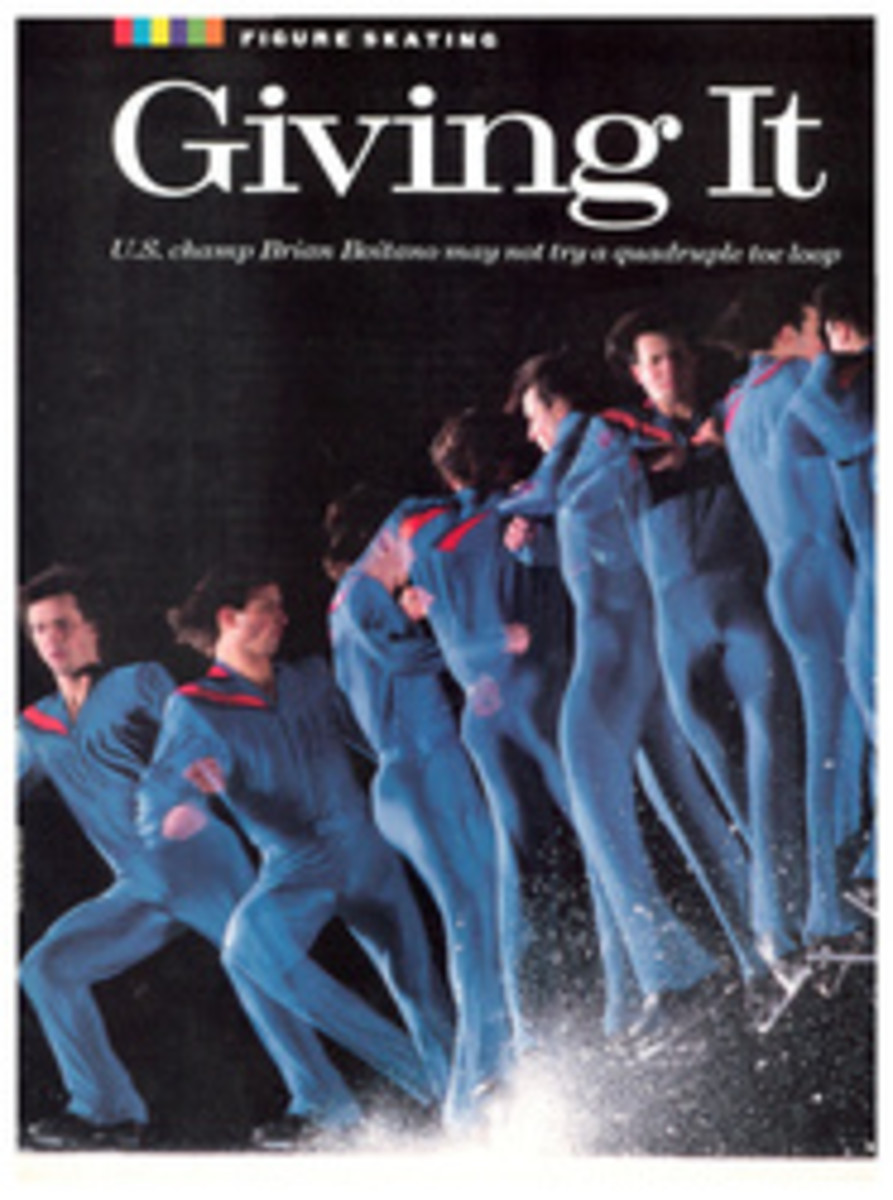
Land of Icy Sports
Manchuria is China's winter playground, a land of snow and ice—mostly ice. It lies in the northeast, tucked up snug against Mongolia and Siberia. Tell a Beijing resident you're heading for Manchuria, and he'll go "Brrrrr." Then he'll ask, "Weishenma?" which, translated, means "Why?"
Manchuria—or Northeast China as the currently preferred nomenclature has it—like many places in the vastness of this country, is remote yet has densely populated urban centers. Its hub is Harbin (pop. 2.5 million, or about the size of Chicago), which is 700 miles from Beijing. Harbin sits on the southern edge of what the Chinese call Da Huang Di, the Great Waste. Beyond Harbin, conditions are too harsh for all but the hardiest folks, most of them farmers.
The streets of Harbin, the capital of Heilongjiang Province, are choked with buses, bikes and horse carts. Russian-and Japanese-style buildings loom above the outdoor markets, reminders of early settlers and subsequent occupations of the 1930s and "40s. The promenade that runs by the bank of the Songhua River is called Stalin Park. In winter, when temperatures head for—40° F, the people of Harbin spend much of each day chopping hard-packed snow from the streets, the Songhua freezes over and kids break out their skates. "All our children love the icy sports." says Pan Jinrun, head of the Heilongjiang Province Physical Culture & Sports Commission. "And some become good at them."
A large majority of China's winter sports stars hail from Harbin and other parts of Manchuria. That's to say, a large majority of a select few. While the People's Republic has gained some prominence in summer sports—it won 15 golds at the L.A. Olympics—it won nary a medal at the two Winter Games it has entered, in 1980 and '84. But the hardworking people of Northeast China are fiercely determined. Only murmurs may be heard from the Chinese at Calgary, but there will certainly be louder sounds at future Winter Games.
Before the Cultural Revolution of the 1960s and '70s, Harbin produced some fine speed skaters. He Gan was one, Liu Fengrong—who was ranked fourth overall in the world among women in 1962 and '63—was another. He and Liu, both Harbiners by birth, are major forces in the renaissance of their sport, he as the national men's coach, she as vice-director of Heilongjiang's sports commission.
"Thirty-five years ago each Harbin school had its own rink, and we were ahead of the world because of our natural conditions." says He looking out over the artificial-ice oval of the Harbin Ice Center. "We had much development in the '50s and '60s. Then the icy sports were interrupted by the Cultural Revolution—a disaster. We lost 10 years. During that period the world began to use artificial ice, and China lagged behind. This oval was completed in 1979, and we have four others like it in the northeast. In recent years our women's speed skating has become very good again, very good. The men's team, I'm sad to say, is still far behind."
Liu agrees that the Chinese women's speed skating team "will be better than at Sarajevo," though she also says. "I don't think there will be a big surprise. No medals."
The objective at Calgary, He says, is to place one or more of the women skaters "within the top 10" in one event or another. "This is the goal set by the state commission. In my opinion, if Wang Shiu Li could squeeze into the top 10 it would certainly be the pinnacle of her career. She's getting old."
It was difficult to watch the 22-year-old Wang zip around the oval at Changchun, a city 145 miles southwest of Harbin where the national team trained, and think of her as old. Veteran, yes: old, no. She has been responsible for China's most shining moments in recent international winter sports competition. At the 1986 World Speed Skating Championships, she was sixth at 500 meters, seventh at 1.500 meters and 11th overall.
Wang is another native Harbiner, the daughter of a construction worker. "I took up skating in school at 10 and quickly learned of Liu and her records," she says. "She became my hero and I wanted to surpass her. The gap between China and a medal is, to be realistic, very wide. But I am hoping, of course."
After speed skating, the quality of China's winter sports program falls off sharply. Among the best of its figure skaters are two Harbiners, Hao Xia Lie, 21, and Liu Lu Yang, 20, who took up the sport at the Doubei District Spare-Time Sports School a decade ago. Hao eventually made it to Sarajevo and finished 19th ice dancing with his partner Xi Hongyan. Shortly after the 1984 Games, coach Li Hong brought Hao and Liu together. "They have been our Chinese pairs champions almost since that day." she says. "They are special together."
Hao and Liu won the gold medal at the Winter Asian Games in 1986, but as Hao says, "That is only Asia. We know there's a gap between us and international champions. We go to Calgary to learn."
"China has no legacy in figure skating as, it has in speed skating," says Li. "We're really just starting. But many children love it. And as they become aware of international stars, this encourages them. The American Tiffany Chin skated in Beijing last year and aroused the people, especially the children." Chin sold out an 18,000-seat arena and created something of a boomlet in figure skating.
Li will travel to Calgary as the pairs' coach. She says there will be Chinese skaters in the singles events, but isn't sure about ice dancing. "No one knows until the sports commission decides," she says.
A small Alpine skiing team will represent the People's Republic at Calgary, but there will be no Chinese ski jumpers, bobsledders or lugers. This isn't surprising, because there are no bobsled or luge runs in China and only a single 45-meter ski jump, in Jalin Province. Qi Qi Ping, team leader for winter sports in Heilongjiang Province, says, "In those places where they have the facilities to ski, they can't buy the skis, or the skis available are poor. In the countryside many children must make their own skates and those have wooden runners. Only here in the cities are conditions such that the athlete can improve as he must."
Nor will China's contingent at the Games include a hockey team, although its national team diligently goes through twice-a-day sessions at the indoor rink in Harbin. "Ice hockey isn't very popular throughout China—only in Harbin," says team leader Jian Ge Xi. Indeed, there are only about 300 top-level hockey players among China's one billion people. Another thousand players compete on sports institute teams. There are two indoor hockey rinks and one outdoors in the 178,996 square miles of Heilongjiang Province. "Equipment is scarce, coaching is scarce," says Jian. "But the athletes are willing."
Against this backdrop of adversity China won the gold medal in ice hockey at the 1986 Winter Asian Games. But the team subsequently failed to qualify for the Olympics and instead has scheduled a playing tour of Australia and Holland for February and March. "There's no doubt we'll be better in years to come," says Jian. "The state has already said it will establish a juvenile team that will begin competing throughout Asia next year."
The march of the People's Republic to winter sports respectability will require more exposure to the world of international sports, and the Chinese know it. Hao and Liu spent September at a figure skating clinic in West Germany. Two of China's top downhill skiers are currently training in Alaska. Two years ago in Harbin the Brown University hockey team lost two out of three games against the People's Republic national team. At the same time the Jilin Province speed skating team was competing in Colorado.
There are half a dozen foreign coaches now working for the China Sports Commission. "The Chinese want to do much of the work, and all of the hard work, themselves." says Gunter Lange, a West German strength coach who has advised Wang and others on conditioning and nutrition. "But they're increasingly willing to ask for help. I'll tell you, they are going to improve. Once they learn a thing, they go at it 120 percent. When our athletes in the West succeed, they walk around like this"—Lange takes a few mincing steps with his nose in the air—"but the Chinese taste success and drive all the harder. Another coach was telling me he was working with athletes in the northeast under conditions—no heat, no water—that Western athletes would not tolerate. He swore that adversity itself made the Chinese bear down."
The hard work is officially encouraged. "The status quo in icy sports in China will change. I say confidently, because the authorities have asked that it change," says Jing Junzhi, vice-director of the ice center in Changchun, Manchuria's third largest city, with a population of more than 1.5 million. "At the third plenary session of the 11th Party Congress, in Beijing, leaders at several levels attached emphasis to improvement in the icy sports."
An optimistic note is also struck by the Heilongjiang sports official, Pan. "Remember, only one generation of athletes has come of age since the Cultural Revolution." he says. "Our goal now is to mobilize more than one million children in the province to do icy sports each year. This is easy because our children do love icy sports."
Indeed they do. Wang Wen Zhe is the principal of Harbin's Doubei District Spare-Time Sports School, where Hao and Liu were first paired on a rink that one recent evening was packed with young children. Last year Wang returned from a conference in Beijing convinced of the need to "grasp sports at an early age." Now Wang has started screening prospective athletes in the kindergarten of his school. "We measure the length of their body and look at their parents' size," he says. "Then we choose."
Jing Den, the five-year-old daughter of a Harbin bus driver and a shopkeeper, is one of Wang's pupils. Her figure skating has improved so much in a matter of months that Wang says a great future may await her. When Den is asked if she wants to go to the Olympics someday, her face lights up and she nods vigorously. Asked if she thinks she will go, and if she will win. Den nods again, more modestly.
In Changchun, Gao Ge, 9, the daughter of the rink manager, has also shown unusual promise in figure skating. As she comes off the ice after her daily practice, she's asked the same questions. She nods excitedly that. Yes, she would like to go to the Olympics. Will she go, and will she win? As she unties her skates, Ge gives a slight, barely perceptible nod.
So it goes with the icy sports in China, so it goes in great white Manchuria, where Olympic glory may be more than just a dream.
PHOTO
HEINZ KLUETMEIER
GE, 9, DREAMS OF THE DAY SHE WILL WIN THE FIGURE SKATING GOLD
TWO PHOTOS
HEINZ KLUETMEIER
ON A HARBIN RINK, NATIONAL MEN'S COACH HE TEACHES SPEED SKATING, CHINA'S BEST WINTER SPORT
TWO PHOTOS
HEINZ KLUETMEIER
WANG (ABOVE), CHINA'S BRIGHTEST OLYMPIC HOPE, WAS INSPIRED BY THE ONCE WORLD-RANKED LIU
PHOTO
HEINZ KLUETMEIER
PAIRS PARTNERS LIU (LEFT) AND HAO MERELY HOPE "TO LEARN"IN CALGARY
THREE ILLUSTRATIONS

